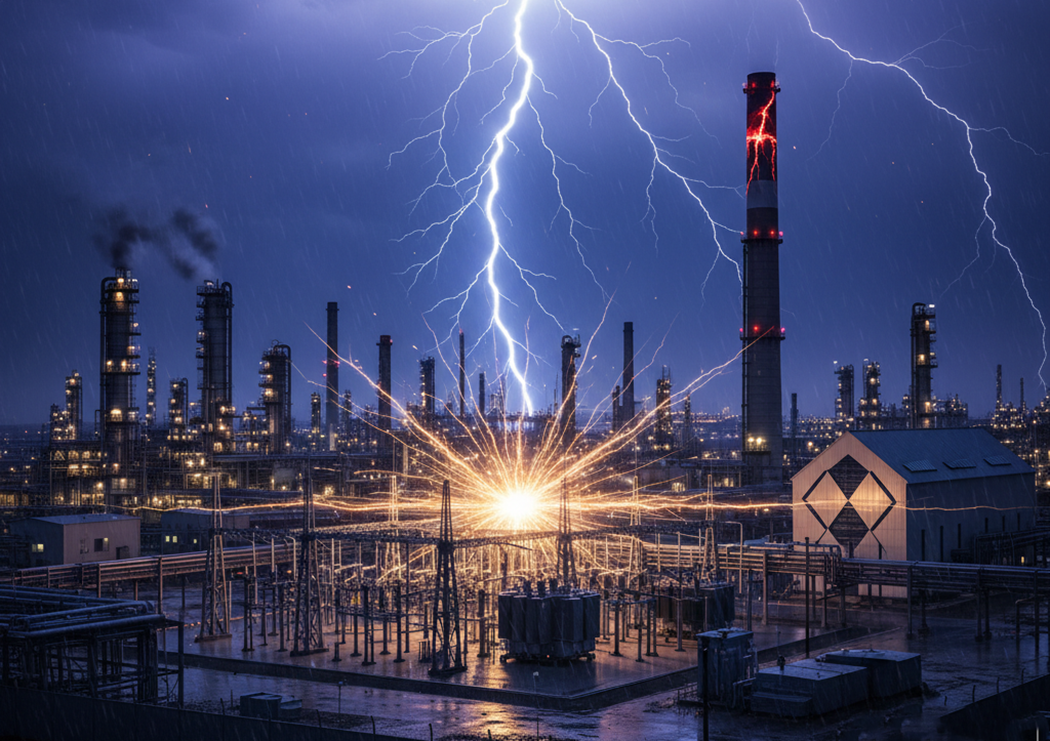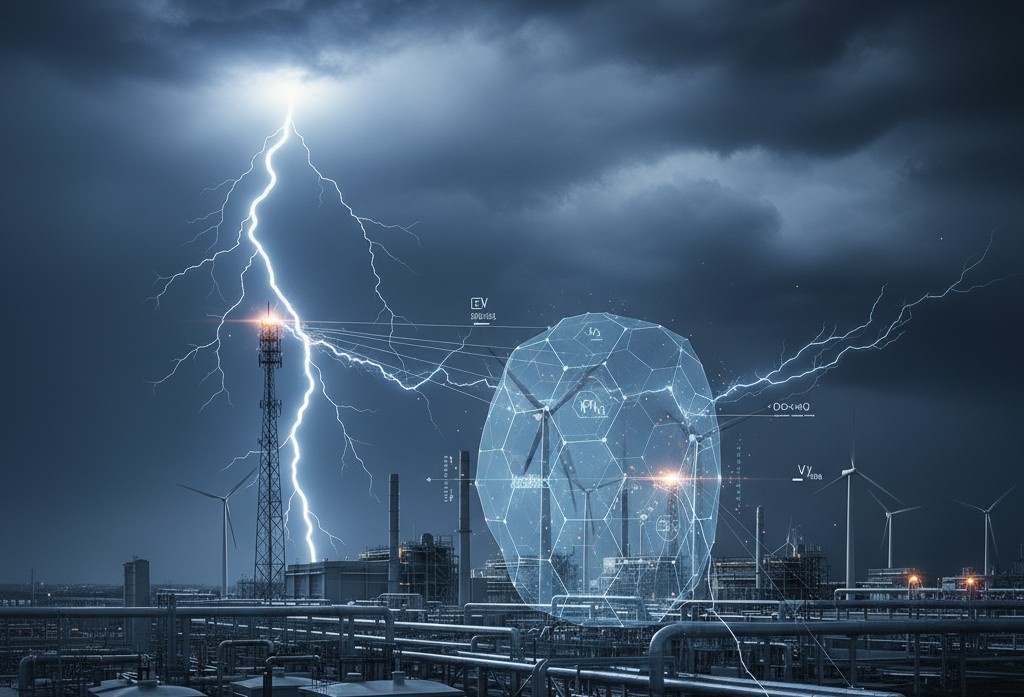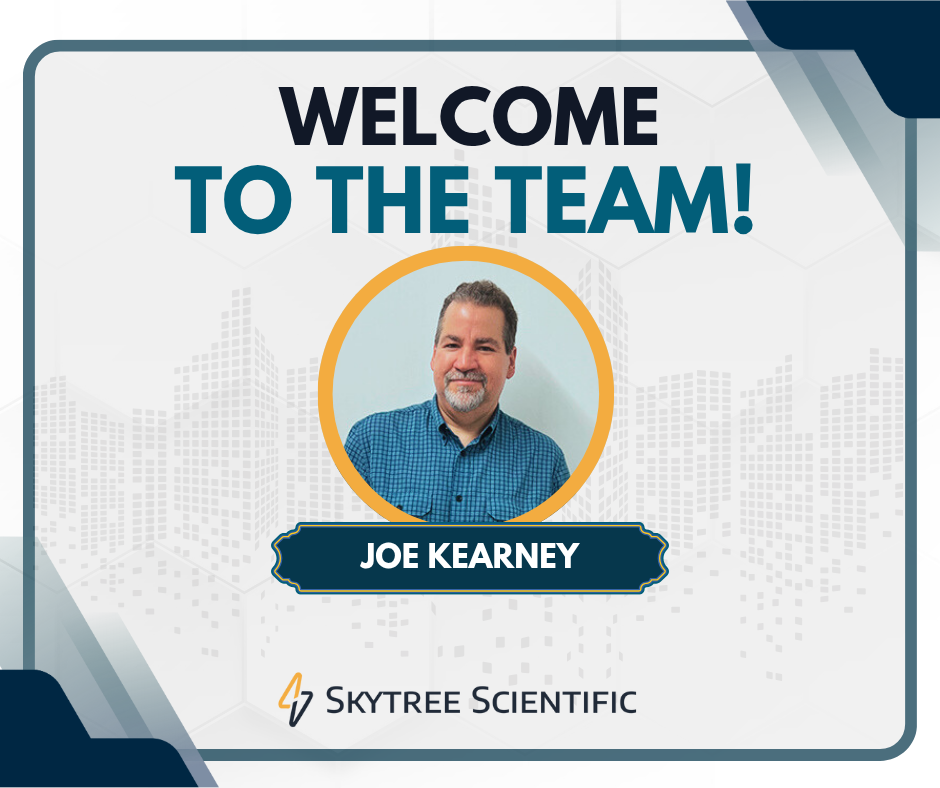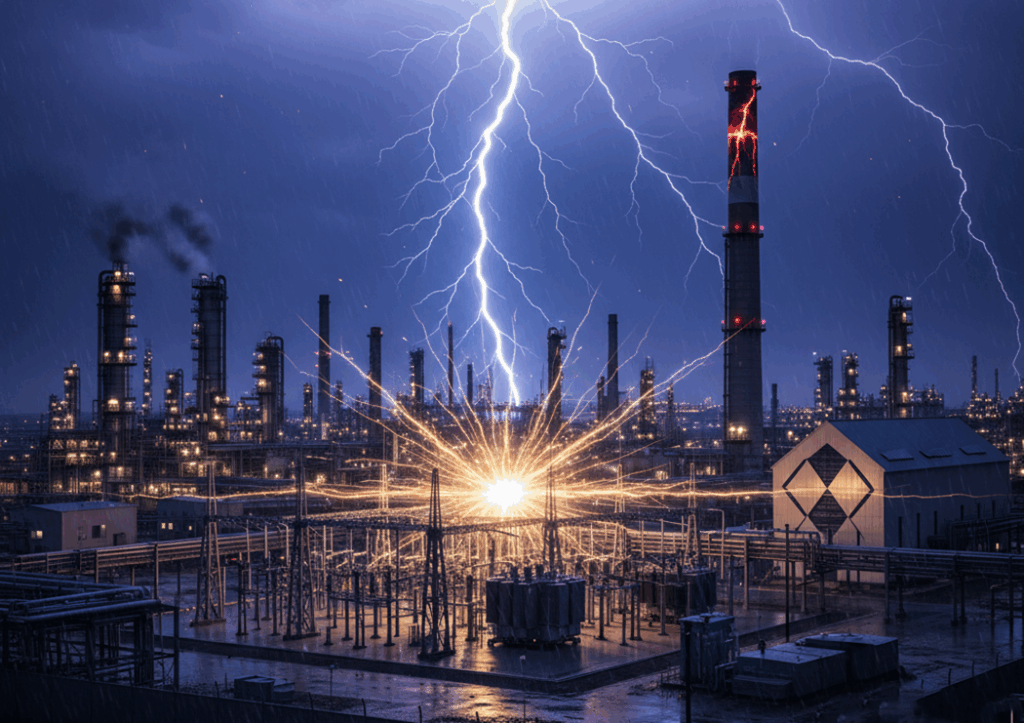Every year, lightning strikes cause billions of dollars in damage to industrial facilities worldwide. A single strike can destroy critical equipment, ignite fires, halt production lines, and create cascading failures across interconnected systems. For industries operating on thin margins or requiring continuous uptime, the financial impact can be devastating.
Unlike residential structures, industrial facilities face unique vulnerabilities. They house expensive specialized equipment, flammable materials, sensitive electronics, and complex control systems – all potential targets for lightning’s destructive energy. The stakes extend beyond immediate property damage to include worker safety, environmental liability, regulatory compliance, and business continuity.
The fundamental question facing facility managers isn’t whether to protect against lightning, but rather: what’s more expensive – prevention or recovery? The answer, backed by decades of industry data, consistently favors proactive protection.
The True Cost of Lightning Damage in Industrial Applications
The financial impact of lightning strikes extends far beyond visible damage. A comprehensive accounting reveals multiple cost categories that quickly accumulate into substantial losses.
Direct Equipment Damage
Lightning delivers enormous electrical energy – up to 200,000 amperes and one billion volts—in microseconds. This wreaks havoc on industrial equipment:
- Electrical Systems: Motors, transformers, and drives suffer catastrophic failure. Industrial motor replacement costs range from $10,000 for small units to over $500,000 for large critical applications.
- Control Systems: PLCs, DCS, and SCADA systems are particularly vulnerable. A single damaged PLC costs $5,000-$50,000 to replace, plus programming labor.
- Process Equipment: Instrumentation, sensors, and monitoring devices throughout facilities may fail due to induced currents.
IT Infrastructure: Servers and network equipment face destruction from surges, with replacement costs often exceeding $100,000. For more on this specialized risk, see our analysis of Lightning Risk for Data Centers.
Production Downtime

For many industrial facilities, the most significant cost isn’t damaged equipment; it’s lost production while systems are offline:
- Manufacturing: Downtime costs range from $10,000 to $250,000 per hour depending on industry
- Energy Sector: A disabled turbine can represent $500,000+ in lost revenue per day
- Chemical Industries: Unplanned shutdowns require careful restart procedures, adding days to recovery
- Data Centers: A single hour of downtime can cost $100,000-$500,000 in lost revenue and SLA penalties.
Additional Cost Categories
- Structural and Fire Damage: Roof repairs ($50,000-$500,000+), fire losses ($1M-$100M+), and smoke/water damage
- Insurance Impacts: Increased premiums, higher deductibles, and potential coverage loss
- Regulatory Costs: Environmental cleanup, OSHA investigations, EPA fines, and legal fees
- Reputational Damage: Lost contracts, penalty payments, customer defection, and brand impact
Industries requiring continuous operations face especially high costs when systems fail, with each hour of downtime rippling through supply chains and customer relationships.
Prevention vs Expense: Why Proactive Protection Pays Off
When comparing lightning protection costs against potential damage, the financial case for prevention becomes compelling.
The Investment in Prevention
A comprehensive lightning protection system for an industrial facility typically includes:
- Lightning Protection System: Air terminals, conductors, grounding ($45,000-$225,000)
- Surge Protection: Service entrance and distribution protection ($17,000-$85,000)
- Risk Assessment and Engineering: Professional assessment and design ($15,000-$65,000)
- Total Investment: $77,000-$375,000 for typical industrial facilities
Annual Maintenance: $4,000-$13,000 for inspections, testing, and repairs
The Math of Prevention
Consider a facility facing a 5% annual probability of significant lightning damage:
Without Protection:
- Average damage per incident: $500,000
- Expected annual cost: $25,000
- 10-year expected cost: $250,000+
With Protection (95% effective):
- Initial investment: $150,000
- 10-year maintenance: $80,000
- Reduced damage risk: $12,500
- 10-year total: $242,500
The protected facility saves money even in this conservative scenario while eliminating catastrophic loss risks.
Beyond Direct Costs
Prevention provides additional value:
- Business continuity and maintained customer relationships
- Insurance premium reductions
- Extended equipment life through reduced electrical stress
- Worker safety protection
- Improved financial planning certainty
Most industrial lightning protection systems achieve positive ROI within 3-7 years. A single prevented major incident typically justifies the entire investment immediately.
Manual vs Software-Based Lightning Risk Assessment
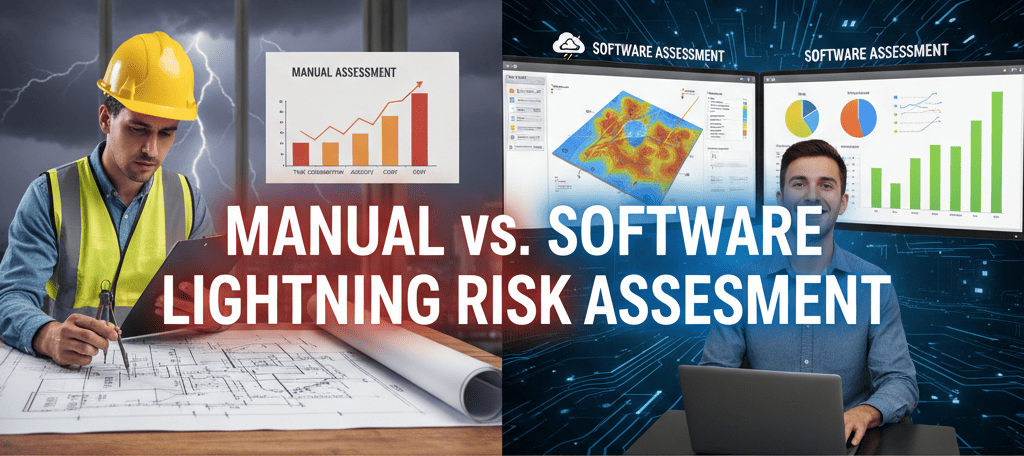
Determining optimal protection levels begins with thorough risk assessment. The methodology you choose significantly impacts accuracy, cost, and decision-making quality.
Manual Risk Assessment
Traditional manual calculations following IEC 62305-2 or NFPA 780 involve gathering facility data, calculating collection areas, assessing damage probabilities, and computing expected losses.
Advantages: Complete control, deep understanding, no licensing costs
Disadvantages: Time-intensive (2-7 days per assessment), error-prone, difficult documentation, requires significant expertise, inconsistent results between assessors
Cost: $5,000-$25,000 per facility by qualified professionals
Software-Based Risk Assessment
Modern software automates calculations while maintaining standards compliance:
Advantages:
- Speed: Complete assessments in 1-4 hours
- Accuracy: Eliminates calculation errors
- Consistency: Standardized methodology
- Documentation: Automated professional reports
- Scenario Analysis: Compare protection options easily
- Scalability: Assess multiple facilities efficiently
Disadvantages: Software licensing costs, learning curve, potential customization needs
Software-based assessments reduce professional time to 1-4 hours, dramatically lowering costs while improving quality. For organizations with multiple facilities, efficiency gains multiply. For detailed comparison, see Manual vs Software Based Lightning Rask Assessment.
The Business Case for Automation
For industrial facilities, software offers compelling advantages in multi-site operations, rapid decision-making, investment justification, ongoing risk management, and compliance documentation. The choice often comes down to frequency and scale – for industrial facilities requiring thorough analysis and potential reassessment, software tools provide superior value.
How Tools Like LRA Plus Reduce Costs and Improve Safety
LRA Plus™ streamlines the entire lightning risk management process, addressing challenges industrial facilities face.
Key Capabilities
Accelerating Assessment: Reduces assessment time from days to hours through guided workflows, automated calculations, integrated lightning data, and template libraries. A 20-hour manual assessment becomes 2-3 hours with LRA Plus™, reducing costs by 80-90%.
Ensuring Compliance: Built-in adherence to IEC 62305-2 standards (NFPA 780 coming in 2026), validated calculations, version control for standard updates, and complete audit trails.
Professional Documentation: Comprehensive auto-generated reports with visual presentations, cost-benefit analysis, and customizable formats help secure budget approval faster.
Multi-Facility Management: Portfolio view, standardized methodology, efficient resource allocation, and trend analysis across organizations.
Scenario Modeling: Quickly evaluate protection options, perform what-if analysis, conduct sensitivity studies, and demonstrate how protection measures reduce risk.
Real-World Impact
Facilities using LRA Plus™ report faster decision-making, higher approval rates for protection budgets, reduced consulting costs, better risk understanding, and improved safety culture. By removing assessment barriers, LRA Plus™ helps facilities implement proper protection, reducing costs and improving safety outcomes.
Best Practices for Reducing Lightning Damage Costs
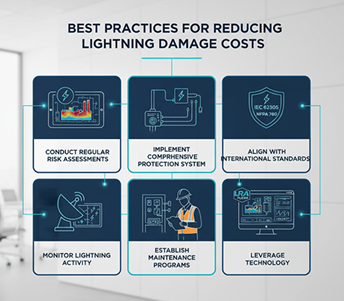
Minimizing lightning-related losses requires systematic approach combining technology, processes, and organizational commitment.
Conduct Regular Risk Assessments – Perform initial baseline assessments, periodic reviews every 3-5 years, trigger-based updates after changes, and portfolio analysis across all facilities.
Implement Comprehensive Protection System – Deploy external protection (air terminals, down conductors, grounding, bonding) and internal protection (multi-stage surge protection at service entrance, panels, and point-of-use). Use certified installers familiar with IEC 62305 or NFPA 780.
Align with International Standards – Compliance with IEC 62305 or NFPA 780 provides insurance recognition, liability protection, and performance assurance.
Monitor Lightning Activity – Subscribe to lightning detection services, document strikes and damage, analyze trends, and verify system performance during actual events.
Establish Maintenance Programs – Conduct annual inspections, perform periodic testing (continuity, ground resistance, SPD verification), make prompt repairs, and maintain comprehensive documentation.
Integrate with Risk Management – Include lightning in emergency response plans, coordinate with insurance, budget for protection, train employees, and establish contractor relationships.
Leverage Technology – Use platforms like LRA Plus™ for current risk evaluations, integrate with asset management systems, automate inspection scheduling, and maintain digital records.
Foster Organizational Commitment – Secure executive sponsorship, engage cross-functional teams, track performance metrics, and continuously improve protection strategies.
Conclusion: Prevention is an Investment, Not an Expense
The financial case for lightning protection is unambiguous. While protection systems require significant upfront investment, the costs pale compared to potential losses from unprotected strikes. When a single incident can result in hundreds of thousands or millions in damage, prevention becomes the only rational choice.
Lightning protection provides decades of protection with minimal ongoing costs, reduces insurance premiums, protects irreplaceable assets, demonstrates due diligence, and eliminates catastrophic loss scenarios that threaten business viability.
Modern tools like LRA Plus™ have removed traditional barriers by making risk assessment fast, accurate, and affordable. What once required days of expert analysis now takes hours, with professional documentation supporting investment decisions and demonstrating compliance.
Taking Action
If your organization hasn’t conducted lightning risk assessments:
- Assess Your Risk: Use tools like LRA Plus™ to quantify exposure and potential losses
- Prioritize Facilities: Focus on highest-risk sites
- Develop Protection Strategies: Design systems aligned with IEC 62305 or NFPA 780
- Secure Investment: Use professional reports to justify budgets
- Implement and Maintain: Install quality systems and establish maintenance programs
The question isn’t whether you can afford lightning protection – it’s whether you can afford to remain unprotected. Every day without adequate protection exposes your organization to potentially catastrophic losses preventable with modest investment.
Prevention is not an expense to minimize – it’s an investment in operational resilience, safety, and long-term financial performance.
Ready to assess your lightning risk? Skytree Scientific’s LRA Plus™ platform provides comprehensive lightning risk assessment according to IEC 62305 standards, with NFPA 780 capabilities coming in 2026. Generate professional risk reports in hours, not days, and make informed decisions about lightning protection investments.

